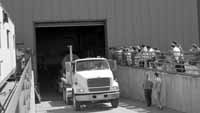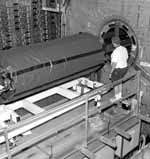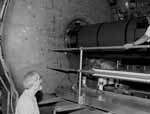 |
|
On the Road with the DZero Tracker by Judy Jackson
It was a beautiful day for a road trip: cloudless blue sky, sun warming a cool dawn, light breeze blowing. The kind of day to fill Žer up, put the top down and head for the highway. And at Lab 3 in the Fermilab Village, a unique road trip was just getting underway. At 10 in the morning of Thursday, June 29, a convoy, led by a Fermilab security car, lights flashing, pulled out of the hardstand parking lot. Behind the lead car, on the back of a flat-bed truck, the DZero fiber tracker slowly--very slowly--began the 2.4 mile trip from its birthplace in Lab 3 to its destination at the heart of the DZero detector. For the tracker, and for the people who had conceived, designed and built it, this final trip, on a beautiful summer morning, was the home stretch of a long road. It had begun more than 10 years ago in the minds of Fermilab physicist Alan Bross and DZero collaborators. They had been thinking about the problem of tracking the charged particles that emerge by the billions from particle collisions deep inside the DZero detector. DZero and its sister detector, CDF, use an array of different technologies, all fitted together with the intricacy of a 5,000-ton Chinese puzzle, to observe and record the results of proton-antiproton collisions at the world's highest-energy particle accelerator, Fermilab's Tevatron. In Tevatron Run I, in the mid-nineties, the two detectors had found the top quark. For Run II, set to begin in March 2001, both detectors would have to be completely reinvented and rebuilt to keep up with a much higher collision rate from a newly souped-up Tevatron. For DZero, an important part of its new capability would be enhanced particle tracking. Bross and his colleagues set their minds to designing a tracker. They based their idea for the new particle tracker on a flash of light. When a fast-moving particle from a collision interacts with a particle of a certain type of plastic, the interaction produces photons of visible light: the plastic scintillates. The scintillations, converted into electronic signals, can pinpoint a particle's path through the detector, and hence its direction and momentum. Using computers trained to recognize the patterns of particles' flight paths, experimenters can identify and analyze the particles themselves. The plan for the fiber tracker envisioned a nest of concentric cylinders, 2.5 meters long and a meter in diameter, hollow at its center. It would fit snugly inside the larger cylinder of DZero's new superconducting solenoid magnet. The hollow center of the fiber tracker, in turn, would hold another detection device, the silicon vertex detector. The tracker would consist of eight cylinders of decreasing radius, nested together like Russian matryushka dolls. Each cylinder would be covered by thousands of scintillating plastic fibers, precisely aligned and connected at their ends to Visible Light Photon Counters. The VLPCs would convert the photons emitted by particle interactions with the plastic fibers to electronic signals. That was the plan. In principle, it would work. In practice, Bross said recently, it took every minute of the 10 years from its conception in 1990 to its departure from Lab 3 on the back of a truck on June 29, 2000 to make the fiber tracker work.
The people who loaded the truck that June morning worked carefully. They took their time handling the 750-pound package, securely wrapped in its blue plastic traveling cover. The object they were loading had cost three million dollars. Hundreds of seven-day weeks and stay-til-midnight shifts lay under its cover. It represented thousands of problems solved: new materials created, tested, rejected, reconfigured, heated, cooled, retested, glued, coated, molded, machined, rejected, redesigned, reworked, retested, assembled, disassembled, reassembled, retested. It was the first and only large fiber tracker detector ever built. They didn't want to drop it.
Again and again, as their project went forward, the tracker group discovered that the materials and devices that they needed for the tracker did not exist. Again and again, they had to learn to make them at Fermilab. The cylinders themselves are a good example.
"We decided to make the cylinders for the tracker out of carbon fiber,Ó explained Fermilab physicist Gaston Gutierrez, who headed the Lab 3 assembly project for the tracker. "It was the strongest, lightest material we could identify. We had been told we could write a P.O. for these cylinders--just go out and buy them. But when we talked to vendors, we found only one who might be able to make what we needed. But the vendor's price was much higher than we could afford. We saw that we would have to make the cylinders ourselves."
The group began a self-taught crash course on carbon-fiber technology. They learned to wrap carbon fibers around steel mandrels. They brought an oven into Lab 3 and baked their creations. Their first efforts came out of the oven and promptly unraveled. They changed the recipe, learning from their mistakes. Eventually, many bakings later, they came up with a double-walled cylinder: strong, light, just what they needed. At less than half the vendor's quoted price. Meanwhile, Bross and collaborators were working with Rockwell International Corp. on the VLPCs. Boeing bought out Rockwell, but work went on seamlessly. Eventually, six iterations later, the VLPCs met specs. With both fibers and cylinders making good progress, it was time to address the problem of putting them together. The fibers would be arrayed in two-layer "ribbons,Ó each containing 256 fibers in a strip about five inches wide, with a tolerance of only 25 microns, about half a hair. The ribbons would be attached to the outside of each cylinder, with one layer of ribbons running along the cylinder's long axis and a second wrapped helically above the first.
That was an understatement. Although prototypes had been made, no one knew how to hold the ribbons together, or how to attach them to the cylinders. A special Teflon-like coating that made the fibers more efficient also made them almost impossible to glue; adhesives just wouldn't stick. Krider went to work. Gutierrez credits Krider with much of the ultimate success of the fiber tracker project. "John is a quiet guy who goes away and thinks about a problem. When he comes back, he has a solution, and it almost always works. His work is all over this tracker."
Now, how to hold the ribbons on the cylinders÷. All the technical challenges had combined to make the fiber tracker something of a problem child for DZero. Every project review found their progress slower than their optimistic goals. In the detector upgrade project, they always seemed to bring up the rear. Finally, in the early fall of 1999, things began to change. "The new lab director came to the detector collaborations, and asked us to tell him how much time we needed to be ready for Run II,Ó remembered Gutierrez. "To answer that question, DZero planned another review. I brought the Lab 3 team together. I said `We can make more promises, we can say we're making progress. Or, we can present a finished cylinder and not say anything.' I told them it was up to them. To finish a cylinder by the time of the review, we would have to work like crazy. We would have to work Saturdays, 12-hour days, there wouldn't be any vacations. I thought we could do it, but it was their choice. They were quiet when I finished, and someone asked about overtime pay. I thought, ŽOh no, if they are doing this just for the money, we'll never make it.' Then one of the technicians raised his fist and said `Yes!' At that moment, I knew we would succeed." The group produced a finished cylinder for the review and never looked back. They loaded the finished tracker. For physicist John Kotcher, DZero's associate project manager for installation and commissioning, tracker moving day was both nerve-wracking and exhilarating. Together with Krider, from Lab 3, and task manager Delmar Miller, at DZero, Kotcher and his crew had gone over every detail of the transfer from Lab 3 to the DZero assembly hall. Using their safety hazard analysis as a guide, they had thought through every step, taken every precaution. "I still had my fingers crossed,Ó Kotcher said. "The transfer points, where we had to pick it up and move it, were the ones where I held my breath." The move went flawlessly. An excited crowd of DZero faithful, (encouraged by Kotcher's broad-cast promise that his colleague, associate project manager Hugh Montgomery, would give a quarter to anyone who turned out) met the truck as it arrived at the assembly hall. A crane lifted the trackerůslowly, slowlyůoff the truck and onto the floor. Next morning, after final preparations, another crane maneuvered it into place for insertion into the DZero solenoid at the detector's center. As the Vaseline jokes flew, the tracker slid slowly into place, with not a micron to spare. Kotcher breathed out. Gutierrez smiled. Bross smiled. University of Rochester physicist Tom Ferbel asked Mont for a quarter. It was the perfect end to a long, long trip. |
| last modified 7/21/2000 email Fermilab |
FRLsDFx9eyfrPXgV

 "I remember the first fiber tracker group meeting,Ó said Bross. "It was on September 7, 1991. At the time, we knew this project would push fiber detection technology. But as it turned out, the technology had much farther to go than we realized."
"I remember the first fiber tracker group meeting,Ó said Bross. "It was on September 7, 1991. At the time, we knew this project would push fiber detection technology. But as it turned out, the technology had much farther to go than we realized."

 "When I came onto the project,Ó said Fermilab engineering physicist John Krider, "it looked like the ribbons were a problem to be solved."
"When I came onto the project,Ó said Fermilab engineering physicist John Krider, "it looked like the ribbons were a problem to be solved."
 Krider consulted adhesives experts and tried dozens of glues. Ultimately, he came up with a flexible glue that held the ribbons together, didn't crack, and could be used in a pressure molding system, also Krider-designed, to produce ribbons with the tolerances the tracker required.
Krider consulted adhesives experts and tried dozens of glues. Ultimately, he came up with a flexible glue that held the ribbons together, didn't crack, and could be used in a pressure molding system, also Krider-designed, to produce ribbons with the tolerances the tracker required.